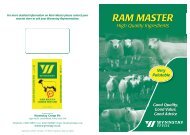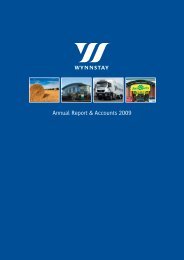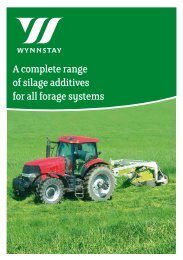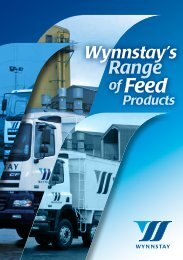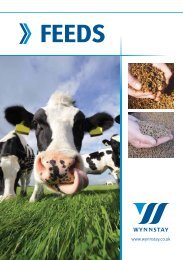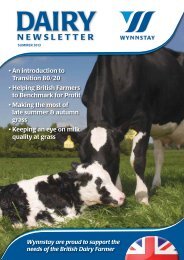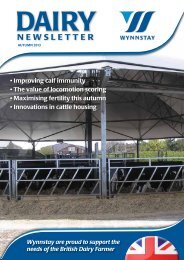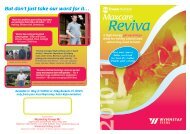Dairy
N e w s l e t t e r - Wynnstay
N e w s l e t t e r - Wynnstay
- No tags were found...
Create successful ePaper yourself
Turn your PDF publications into a flip-book with our unique Google optimized e-Paper software.
DON’T TAKE YOUR EYE OFF HYGIENE<br />
DURING THE SUMMER MONTHS<br />
Just because the cows are out, it doesn’t mean that shortcuts can be taken with dairy hygiene routines. According to<br />
Adrian Morgan from Wynnstay, there are plenty of sensible reasons to keep hygiene high on the agenda.<br />
While cows might look contented when out at grass<br />
and appear considerably cleaner than when housed,<br />
they are still exposed to similar risks of bacterial<br />
infection. It is all too easy to lapse into a false sense of<br />
security, assuming cows are cleaner when in reality full<br />
hygiene procedures should be maintained. Every year<br />
we see a significant number of problems associated<br />
with high bactoscans and rising cell counts during the<br />
summer, most of which could have been prevented if<br />
full hygiene programmes had been continued.<br />
A herd cell count problem will not simply go away<br />
just because the cows are out at grass. The infection is<br />
within the udder. To keep on top of existing infections<br />
it is essential to follow the proven five-point mastitis<br />
programme and maintain effective hygiene practises<br />
in the parlour.<br />
Never assume teats are clean. Cows lying down on<br />
a field of fresh grass may look a natural and clean<br />
sight but they will still be exposing the udder to dirt<br />
and bacteria. This is particularly true after a wet spell.<br />
Scrupulous udder hygiene must be maintained and<br />
nothing should be taken for granted. Use a premilking<br />
biocidal preparation to ensure the removal of<br />
bacteria from the teats before the unit is applied and<br />
increase the attention given to teat preparation in wet<br />
weather. Teat skin and teat ends must be clean and<br />
dry before unit attachment.<br />
Post milking teat disinfection is another area where<br />
attention to detail will pay dividends. While it may<br />
be tempting to swap to a summer product the instant<br />
the cows are out at grass, it is sensible to carry on<br />
with the winter product for a time until cows are fully<br />
out. Maintaining healthy teat skin, rather than relying<br />
on a fire fighting approach with creams and salves is<br />
paramount.<br />
Pay attention to cubicles and loose yards. Many<br />
farmers will keep cows in at night initially. It is<br />
important however that just because the cows are<br />
only housed part of the day, it does not mean cutting<br />
back on housing hygiene. Keep bedding fresh,<br />
passageways clean and beds disinfected to minimise<br />
the threat of bacteria.<br />
Once the cows are out day and night take the<br />
opportunity to clean and disinfect the buildings. The<br />
sooner housing is mucked out and cleaned the better,<br />
as by doing so it removes areas where flies and vermin<br />
can live and breed and exposes parts of the building<br />
that requires repair and attention before restocking.<br />
And once the buildings have been cleaned, prevent<br />
cows from having access to them.<br />
Finally, take the time to review any hygiene problems<br />
you had during the winter, such as high bactoscans or<br />
peaks in the number of clinical mastitis cases. If you<br />
can identify the reasons for the problems you can take<br />
steps over the summer to prevent them reoccurring<br />
next winter.<br />
Low bactoscans don’t necessarily<br />
mean clean milk<br />
The production of quality raw milk is under scrutiny yet again as more focus is<br />
being placed on producing milk with low Thermoduric levels.<br />
Thermoduric bacteria are increasingly becoming an issue in raw milk supplies and<br />
if they are not removed at the end of milking by an effective cleaning routine they<br />
will stay in the plant to multiply in large numbers and be swept away into the bulk<br />
tank at the next milking.<br />
Thermoduric are organisms which have developed mechanisms to resist heat<br />
treatment and can survive in small numbers during milk processing to become<br />
spoilage organisms in finished products such as cheese, yogurt and fresh milk.<br />
Although Thermoduric bacteria may not be of particular concern to the dairy<br />
farmer, their presence can have an influence on the Bactoscan results if present<br />
in large enough numbers and therefore should not be dismissed simply as a<br />
processing issue.<br />
In raw milk, Thermoduric organisms originate from sources in the cows environment<br />
such as soil, fodder, silage, dust and the cows coat. These organisms can grow<br />
readily on poorly cleaned and sanitised milking equipment.<br />
• High levels above 500cfu/ml are a good indicator of poor milking plant or bulk<br />
tank cleaning. Common faults with cleaning are:<br />
• Inadequate volumes of water at each stage of the wash<br />
• Poor water temperatures and profiles during the hot wash<br />
• Poor choice or under dosing of chemical<br />
• Poor flow and turbulence of water (mechanical action)<br />
• Failure to include a terminal disinfection in the final rinse<br />
• Inadequate milk stone removal treatment particularly in hard water areas<br />
Parlour hygiene should not be thought of as a standalone task, but as part of<br />
a total hygiene management system encompassing pre-milking hygiene, udder<br />
hygiene and bulk tank cleaning as well as cleaning the parlour itself. It is only by<br />
operating a managed system that optimum hygiene can be achieved across the<br />
milking process.<br />
With this in mind it should be remembered that it is also possible and should not<br />
be overlooked, that some Thermoduric organisms can be derived from the cows<br />
teats and gain access to the raw milk supply through inadequate teat preparation.<br />
The use of a pre-milking teat disinfectant to reduce bacteria on the teat skin<br />
16<br />
www.wynnstay.co.uk<br />
followed by thorough removal with individual paper towels or cloths will produce<br />
the best and most consistent results.<br />
Where high Bactoscan issues are being experienced it is worth considering a bulk<br />
tank bacteriology sample which will highlight organisms of concern and potential<br />
solutions, depending on the numbers and combinations of bacterial groups found.<br />
An effective routine depends on four factors – chemical choice and concentration,<br />
temperature, time and the physical action of the water. These factors work in<br />
combination with one another and if any of them are compromised then the<br />
routine will not be fully effective.<br />
Modern dairy chemicals are designed to work at a specific concentration. Reducing<br />
this concentration by over-diluting the chemical means that there is less active<br />
ingredient in circulation and this will reduce the effectiveness of bacterial kill and<br />
deposit removal.<br />
Reducing the time the chemical circulates will have the same effect, as the total<br />
exposure of the plant to the chemical is reduced. But leaving chemicals circulating<br />
too long is also a problem.<br />
Temperature is an essential element in the effective melting of fat deposits and<br />
the removal of Thermoduric bacteria that could otherwise survive heat treatment.<br />
The aim should be to circulate the chemicals at a temperature of at least 65°C for<br />
3 minutes.<br />
While it is tempting to leave the circulation cleaning running while other jobs are<br />
carried out there is a real risk that it will be left running too long and that water<br />
temperature will drop too low to maintain the suspension of deposits in solution,<br />
thus re-depositing them back into the parlour.<br />
The final key element in an effective cleaning routine is water turbulence. The<br />
swirling action of the water plays a critical role in the removal of deposits,<br />
especially in the claw and milk meters.<br />
With the current focus on maximising milk bonuses and controlling costs, the time<br />
spent reviewing the effectiveness of the parlour cleaning routine can be time well<br />
spent as it could increase milk price and save money.<br />
Adrian Morgan<br />
<strong>Dairy</strong> Business Development Manager<br />
M: 07780 683043<br />
adrian.morgan@wynnstay.co.uk




